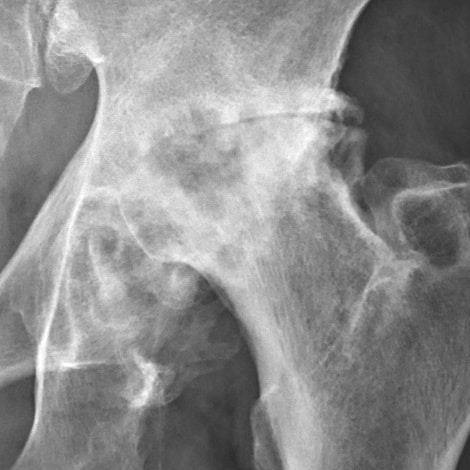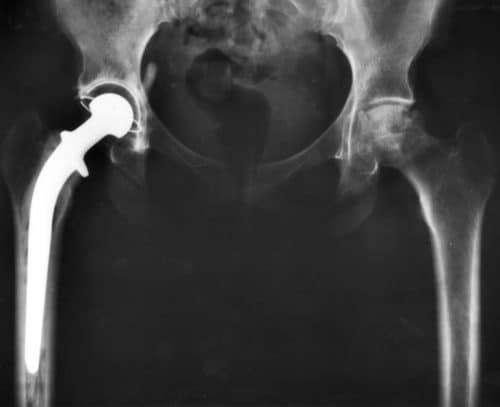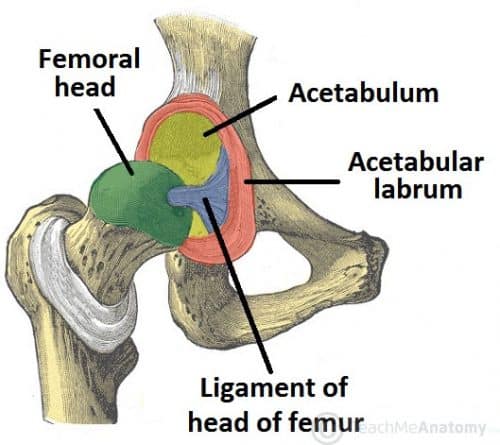Osteoarthritis (OA) is a degenerative joint disease characterised by loss of articular cartilage. This is associated with periarticular bone response, the features of which are seen on the radiographs.
It is extremely common, and prevalence increases with age. It is the most common cause of disability in the Western world in older adults. The hip is the second most commonly affected joint, with the knee the most.
In this article, we shall look look at the risk factors, clinical features and management of hip osteoarthritis. OA affecting other joints is discussed more generally here.
Risk Factors
The risk factors for hip OA can be categorised into:
- Systemic – Increasing age (>45 yrs), obesity, female gender, genetic factors*, vitamin D deficiency
- Local – History of trauma to the hip, anatomic abnormalities, muscle weakness or joint laxity, participation in high impact sports
*Evidence shows there is an estimated heritable component of hip OA is between 50-65%
Clinical Features
Pain is the leading feature, most commonly felt in the groin, however can also present over the lateral hip or even deep in the buttock. Pain is aggravated by weight-bearing and improved with rest. It is invariably worse towards the end of the day and better in the mornings.
Other symptoms include stiffness, which improves with mobility, or an associated grinding or crunching sensation.
On examination, they will have an antalgic gait and may walk with a mobility aid. There is very little to find on palpation.
Passive movement is painful and, in severe OA, the range of motion is reduced. In end stage disease, the patient may have a fixed flexion deformity and walk with a Trendelenburg gait.
Differential Diagnoses
- Trochanteric bursitis – presents with lateral hip pain radiating down the lateral leg, with associated point tenderness over the greater trochanter
- Gluteus medius tendinopathy – lateral hip pain with point tenderness over the muscle insertion at the greater trochanter
- Sciatica – low back pain and buttock pain, but often radiates down the posterior leg to below the knee. Diagnosis is made with the straight leg raise to produce Lasègue’s sign
- Femoral neck fracture – most commonly there will be a history of trauma or known severe osteoporosis (if it is a stress fracture); the patient will be unable to weight bear due to pain and the limb will appear shortened and externally rotated
Investigations
Hip osteoarthritis is demonstrated readily on plain radiographs (Fig. 2). The features* include:
- Narrowing of the joint space
- Osteophyte formation
- Sclerosis of the subchondral bone
- Subchondral bone cysts
Additional further imaging is rarely required, unless other diagnoses are being considered, when an MRI is usually gold-standard.
*Only one or two of these markers may be present; osteophyte formation tends to be evident only in later stages of the disease

Figure 2 – Plain radiograph showing features of severe hip OA
Classification of OA Progression
There are a number of different tools to classify the progression of OA.
The Western Ontario and McMaster Universities Arthritis Index (WOMAC) is a well-evaluated measure, which combines 5 items for pain (0-20), 2 items for stiffness (0-8) and 17 items for function (0-68), giving an overall total out of 96.
This tool can be repeated to allow for a quantitative evaluation of disease progression.
Management
Initial Management
Adequate pain control is important, using the WHO analgesic ladder, to ensure ongoing mobility and quality of life. Lifestyle modifications are also essential in aiming to improve self-management, including weight loss, regular exercise, and smoking cessation.
Physiotherapy is essential and should be provided for all individuals with hip OA, aiming to slow disease progression and improve joint mechanics.
Long-Term Management
If conservative management efforts do not work, surgical intervention is warranted.
Definitive treatment is with a hip replacement, either as a total hip replacement (arthroplasty, Fig. 3) or a hemiarthroplasty. Several surgical approaches for these procedures are available (see below)
Common post-operative complications include thromboembolic disease, bleeding, dislocation, infection, loosening of the prosthesis, and leg length discrepancy.

Figure 3 – Pelvic AP radiograph showing a right Total Hip Replacement
Surgical Approaches
There are a number of different approaches to hip replacement surgery that can be taken, defined by their relation to gluteus medius:
- Posterior Approach – The most common approach, as rehabilitation is often fast due to preservation of the abductor mechanism, minimising the risk of abductor dysfunction post-operatively
- There is the greatest risk of causing damage to the sciatic nerve and of dislocation
- Anterolateral Approach (Modified Hardinge approach) – The abductor mechanism is detached to allow excessive adduction and thus full exposure of the acetabulum
- A merit of this method is that the superior retinacular vessels are not interrupted lowering the risk of avascular necrosis, however there is a risk of damage to the superior gluteal nerve
- Anterior Approach (Smith-Petersen approach) – This approach is rarely used in adult arthroplasty in the UK, most commonly used in open washouts of infected native hips
Complications
A modern hip prosthesis is designed to last for 15-20 years; therefore, depending on the age at time of replacement, it may never need revising. Nevertheless, revision hip arthroplasty is increasingly common.
Key Points
- The hip is the second most commonly affected joint in the body for osteoarthritis
- Patients present with a dull aching pain, aggravated by activity and relieved by rest, with associated joint stiffness, especially after a period of immobility
- Diagnosis is made clinically however can be confirmed with a plain radiograph
- Conservative management should be trialled initially, however if there is no improvement then surgical intervention may be warranted


